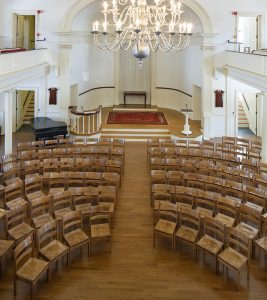
The meaning of “sanctuary” has evolved significantly over the approximately seven centuries since the word was first coined. The English word comes from the Latin “sanctuarium,” which in turn is derived from “sanctus,” an adjective meaning “holy.” In its original form, a sanctuary was quite literally a holy place—a space for holy worship or a reliquary for holy artifacts.
In the fourteenth century, this meaning began to broaden to include a non-ecclesiastical place of refuge or protection. In 1879, “sanctuary” acquired another meaning: land set aside for plants or animals to breed, protected from hunting or harvesting.
So now, in the modern era, the word “sanctuary” has a trinity of meanings: holy space; place of asylum; and nature reserve. These meanings often interweave and shade the nuances of one another. Students discussing sanctuary at a Soup, Salad & Soul lunch recently talked about how natural spaces often feel sacred and safe, removed from the mundane—a union of everything the word has come to mean.
Here in Helen Hills Hills Chapel, programs like Soup, Salad & Soul offer students sanctuary from their busy, task-oriented lives. The sanctity lies in the chance to eat food not simply as fuel but as welcome nourishment; to discuss meaningful topics not to learn material for a test or to win an argument, but simply for the sake of exploring them; to slow down, if only for an hour or so, and recalibrate. We do not offer students immunity from manslaughter charges, as Biblical sanctuaries did, but we do offer them refuge from deadlines and stress!
The Smith Center for Religious and Spiritual Life, like many Houses of Worship, has a Sanctuary, a room set aside for worship. For many decades the Sanctuary had rows of wooden pews: it was a designed in the style of the traditional New England “meetinghouse,” which was associated with the Protestant Church and the Congregationalist denomination. However, the CRSL “sanctuary” has been designated as a multifaith worship space, a performance venue for music and theatre, a convening space for student activism, and a gathering place for soulful discussion, contemplative practice, and meditation.
As a reflection of this broad sense of sanctuary, the Protestant style pews were removed in 2013 and have been replaced by moveable chairs that can be arranged to suit a wide variety of activities, and stored to open the floor altogether. Thus this sacred space is now even better suited to be a place where students of all faith backgrounds, (including those with no faith background) and spiritual inclinations, can continually explore and redefine what sanctuary—with all its myriad interpretations—means to them.

Pingback: Walking About Smith As Us: | Muslim Students’ Perspectives | Smith College Center for Religious and Spiritual Life